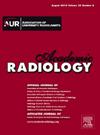On-Call Radiology Resident Preliminary Report Major Discrepancies: A Meta-analysis
IF 3.8
2区 医学
Q1 RADIOLOGY, NUCLEAR MEDICINE & MEDICAL IMAGING
引用次数: 0
Abstract
Rationale and Objectives
Throughout their training, radiology residents frequently perform independent overnight call, with attendings overreading reports the following morning. Call shifts are a fundamental part of radiology resident training, offering independence that can improve decision-making skills and professional confidence. However, because errors have the potential to affect patient care, analysis of clinically significant errors is critical. This meta-analysis was performed to organize existing data on on-call resident preliminary report discrepancy rates and to compare rates across modalities and resident years.
Materials and Methods
A PubMed search was performed in August 2024 using ("resident report discrepancy" OR ("resident" AND "error") OR "preliminary") AND "radiology" AND "call”. Articles were included if they met the criteria, and relevant information was collected. Statistical analysis was performed.
Results
The PubMed search resulted in 107 articles, of which 20 met inclusion criteria. These studies included 616,918 preliminary reports. Pooled preliminary report major discrepancy rate (%) by modality was 0.64 for radiographs, 0.38 for US, 1.35 for CT, and 1.86 for MRI and by resident year was 1.27 for R1s, 1.05 for R2s, 0.88 for R3s, and 0.67 for R4s. The highest discrepancy rate was seen for R1s reading MRI (8.70%). The majority of papers included describe residents taking independent call, with only three having fellow or attending supervised call part of the time.
Conclusion
Radiology residents are valuable members of the healthcare team and demonstrate high accuracy during independent call shifts. Fellow or attending real-time supervision can shorten the time to final report, and whether a hospital implements this should be decided by analyzing its individual system. This analysis is limited by variability in the classification of major discrepancies and inability to further classify data by body region scanned. In light of this, we encourage standardization in future reporting.
随叫随到的放射科住院医师初步报告主要差异:一项荟萃分析
基本原理和目的在整个培训过程中,放射科住院医生经常在夜间独立出诊,而主治医生会在第二天早上过度阅读报告。呼叫轮班是放射科住院医师培训的基本组成部分,提供独立性,可以提高决策技能和专业信心。然而,由于错误有可能影响患者护理,对临床显著错误的分析至关重要。本荟萃分析的目的是组织关于随叫随到的住院医师初步报告差异率的现有数据,并比较不同模式和住院医师年限的差异率。材料与方法于2024年8月使用(“住院医师报告差异”或(“住院医师”和“错误”)或“初步”)和“放射学”和“呼叫”进行PubMed检索。符合标准的文章被纳入,并收集相关信息。进行统计学分析。结果PubMed检索到107篇文章,其中20篇符合纳入标准。这些研究包括616,918份初步报告。综合初步报告的主要差异率(%),x线片为0.64,US为0.38,CT为1.35,MRI为1.86,r15为1.27,r15为1.05,r3为0.88,r4为0.67。r15阅读MRI的差异率最高(8.70%)。大多数论文都描述了住院医生的独立电话,只有三篇论文在部分时间里有同伴或参加监督电话。结论放射科住院医师是医疗团队的重要成员,在独立值班时表现出较高的准确性。同伴或参加实时监督可以缩短到最终报告的时间,医院是否实施该制度应通过分析其个别系统来决定。这种分析受到主要差异分类的可变性和无法进一步按扫描的身体区域分类数据的限制。鉴于此,我们鼓励未来报告的标准化。
本文章由计算机程序翻译,如有差异,请以英文原文为准。
求助全文
约1分钟内获得全文
求助全文
来源期刊

Academic Radiology
医学-核医学
CiteScore
7.60
自引率
10.40%
发文量
432
审稿时长
18 days
期刊介绍:
Academic Radiology publishes original reports of clinical and laboratory investigations in diagnostic imaging, the diagnostic use of radioactive isotopes, computed tomography, positron emission tomography, magnetic resonance imaging, ultrasound, digital subtraction angiography, image-guided interventions and related techniques. It also includes brief technical reports describing original observations, techniques, and instrumental developments; state-of-the-art reports on clinical issues, new technology and other topics of current medical importance; meta-analyses; scientific studies and opinions on radiologic education; and letters to the Editor.
 求助内容:
求助内容: 应助结果提醒方式:
应助结果提醒方式:


